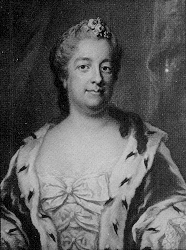Eva Ekeblad
| Eva Ekeblad | |
|---|---|
|
Eva Ekeblad | |
| Born |
July 10, 1724 Sweden |
| Died |
May 15, 1786 Sweden |
| Residence | Stockholm and Västergötland |
| Citizenship | Swedish |
| Fields | Agronomy |
| Known for | Making alcohol of potatoes (1746) |
| Influenced | Reduced the hunger by making potatoes a basic food. |
| Notable awards | Membership in the Royal Swedish Academy of Sciences (1748) |
| Notes | |
|
First woman in the Royal Swedish Academy of Sciences: full member 1748-51, honorary member 1751-86. | |
Eva Ekeblad (10 July 1724 – 15 May 1786), née Eva De la Gardie, was a Swedish agronomist, scientist, Salonist and noble (Countess). Her most known discovery was to make flour and alcohol out of potatoes (1746). She was the first female member of the Royal Swedish Academy of Sciences (1748).[1][2][3]
Biography
Background and private life
Eva De la Gardie was born to statesman count Magnus Julius De la Gardie (1668–1741) and the amateur politician and salonist Hedvig Catharina Lilje: sister of Captain Carl Julius De la Gardie and Hedvig Catharina De la Gardie and the aunt of Axel von Fersen the Younger. Her brother was the spouse of the famous Cathérine Charlotte De la Gardie and the brother-in-law of the royal favourite Hedvig Taube.[1][3][4][5]
Eva was at the age of 16 (1740) married to the statesman count Claes Claesson Ekeblad, and became the mother of seven children (one son and six daughters).[1][6] The couple had a residence in Stockholm and an estate in Västergötland and belonged to the very highest circles of the Swedish nobility.[1][2] Eva Ekeblad was renowned for her charity to the poor.[3]
Her spouse was often absent, and Eva was responsible for the management for the estates and supervised the bailiffs and the country-assemblys of Mariedal and Stola Manor.[1][3][7] In Stockholm, she hosted a culturel salon and was described as "one of few aristocratic ladies whose honour was considered untainted".[1] The first concert performings of the mass music of Johan Helmich Roman were performed in her salon at the Ekeblad palace.[8]
Scientific activity
In 1746, Ekeblad wrote to the Royal Swedish Academy of Sciences on her discoveries of how to make flour and alcohol out of potatoes .[1][2]
Potatoes had been introduced into Sweden in 1658, but until then only cultivated in the greenhouses of the aristocracy. Ekeblad's work turned potatoes into a staple food in Sweden; it also increased the supply of wheat, rye and barley available for making bread, since potatoes could be used instead to make alcohol. This greatly improved the country's eating habits and reduced the frequency of famines. [2]
She also discovered a method of bleaching cotton textile and yarn with soap in 1751,[1] and of replacing the dangerous ingredients in cosmetics of the time by using potato flower (1752); she is said to have advertised the plant by using it's flowers as hair ornaments.[2]
In 1748, Eva Ekeblad became the first woman elected to Royal Swedish Academy of Sciences, although she never took part in any of the Academy's meetings. After 1751, the Academy came to refer to her as an honorary rather than a full member, as the statutes confined membership to men.[1]
See also
References
- ↑ 1.0 1.1 1.2 1.3 1.4 1.5 1.6 1.7 1.8 Riksarkivet Band 12 (1949), p.637
- ↑ 2.0 2.1 2.2 2.3 2.4 http://www.bgf.nu/ljus/u/ekeblad.html
- ↑ 3.0 3.1 3.2 3.3 Anteckningar om svenska qvinnor, P. G. Berg. 1864 , pp.130-131
- ↑ Svenskt biografiskt handlexikon Herman Hofberg et al., 1906. p. 234
- ↑ Svenskt biografiskt handlexikon Herman Hofberg et al., 1906. p. 492
- ↑ http://www.historiesajten.se/visainfo.asp?id=582
- ↑ Gatunamn med historia - Ekebladsvägen – Tore Hartung, sept 2001
- ↑ Riksarkivet Band 30 (1998-2000), p.292 - Johan Helmich Roman
